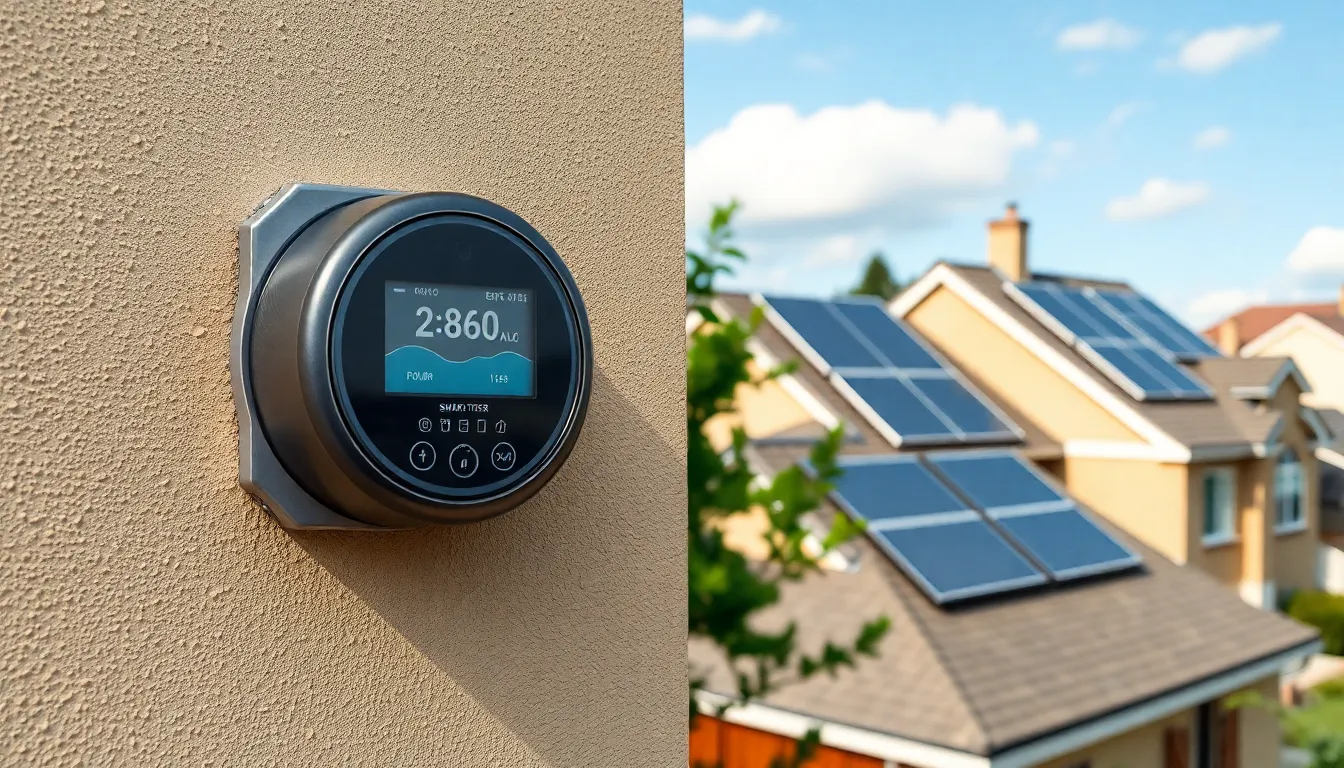Table of Contents
ToggleImagine a world where your toaster and fridge are in a heated debate over who uses more energy. Welcome to the realm of IoT smart grids, where appliances aren’t just appliances—they’re savvy energy managers. These grids are revolutionizing how we generate, distribute, and consume electricity, making your home smarter and your energy bills lighter.
Overview of IoT Smart Grids
IoT smart grids integrate Internet of Things technology into energy networks. These grids utilize smart meters, sensors, and connected devices to facilitate real-time communication between energy producers and consumers. Enhanced operational efficiency results from this seamless interaction.
Power plants and renewable energy sources benefit from increased data insights, allowing for better load management. Improvements in energy distribution occur as these grids monitor and react to real-time demands. Enhanced reliability and reduced outages become possible through advanced analytics and predictive maintenance.
Consumers gain control over their energy usage, leading to more informed decisions. Smart appliances automatically adjust energy consumption based on availability and pricing. Automated responses contribute to a significant reduction in energy costs, enhancing user satisfaction.
Environmental impacts decrease as renewable energy sources integrate into the system. Smart grids enable the effective management of solar, wind, and other sustainable resources. A more stable energy supply becomes achievable through the reduction of reliance on fossil fuels.
Security remains a priority in the design of IoT smart grids. Measures against cyber threats necessitate robust security protocols. Encryption and constant monitoring ensure the integrity of data exchanged within the grid.
Innovation plays a key role in the evolution of these smart grids. New technologies emerge continuously, focusing on efficiency, sustainability, and user engagement. The transition to smart grid infrastructure fosters economic growth and supports energy independence.
Key Components of IoT Smart Grids

IoT smart grids rely on several critical components that enable efficient energy management and consumption.
Sensors and Devices
Sensors and devices function as the backbone of IoT smart grids. Smart meters measure energy usage in real-time, allowing consumers to track their consumption accurately. Connected appliances communicate with the grid, optimizing energy use based on demand and pricing. Distributed energy resources, such as solar panels, contribute data to enhance system performance. Advanced sensors monitor grid health and detect outages quickly. These innovations ensure that energy flows smoothly from producers to consumers while promoting sustainability.
Communication Networks
Communication networks connect various elements within the smart grid. Wireless and wired technologies, including cellular and mesh networks, facilitate real-time data exchange between devices. Robust protocols ensure reliable communication, which enhances grid resilience. These networks enable two-way communication, allowing feedback from consumers and producers alike. Utilizing secure channels protects sensitive information, crucial for maintaining trust. Seamless connectivity supports efficient load balancing and grid management, leading to optimal energy distribution.
Data Analytics
Data analytics plays a vital role in optimizing IoT smart grids. Collected data from sensors and devices undergoes analysis to uncover usage patterns and trends. Advanced algorithms help forecast energy demand, enabling efficient resource allocation. Predictive analytics identifies potential failures, facilitating proactive maintenance. Insights derived from analytics empower consumers to make informed decisions regarding their energy consumption. As a result, increased operational efficiency and reduced costs contribute to a more sustainable energy future.
Benefits of IoT Smart Grids
IoT smart grids provide numerous advantages, enhancing the electrical landscape significantly. Notably, energy efficiency, reliability, and sustainability stand out as key benefits.
Energy Efficiency
Enhancing energy efficiency occurs through the utilization of smart appliances and real-time data. Smart meters enable users to monitor consumption patterns closely, allowing proactive adjustments. Devices communicate based on energy availability, ensuring reduced waste. Consumers experience lower energy bills as they shift usage to off-peak hours. Increased automation streamlines energy management, improving overall efficiency. Ultimately, optimal energy use conserves resources and benefits the environment.
Enhanced Reliability
Enhanced reliability marks another significant advantage of IoT smart grids. Real-time monitoring of the grid ensures immediate detection of issues. Predictive analytics facilitates timely maintenance, preventing outages before they occur. Smart grids adapt to demand fluctuations swiftly, keeping services stable. Integration of renewable sources also strengthens reliability by diversifying supply options. As a result, users enjoy uninterrupted power, enhancing their day-to-day experience.
Sustainable Practices
Sustainable practices thrive within the framework of IoT smart grids. By incorporating renewable energy sources, these grids minimize reliance on fossil fuels. Advanced analytics optimally integrate solar and wind power, maximizing their usage. Users contribute to environmental conservation by choosing cleaner energy options effortlessly. Smart grids also support electric vehicle charging infrastructure, promoting green transportation solutions. Focus on sustainability not only supports the planet but also aligns with growing consumer demand for environmentally responsible energy solutions.
Challenges in Implementing IoT Smart Grids
Implementing IoT smart grids presents several challenges that stakeholders must address.
Security Concerns
Cybersecurity poses a significant challenge in IoT smart grids. With increased connectivity comes an elevated risk of cyberattacks. Protecting sensitive data requires robust encryption methods and constant monitoring. Attackers might exploit vulnerabilities in smart meters and connected devices. Ensuring data integrity and privacy remains crucial, necessitating continual updates to security protocols. Organizations must prioritize training for personnel to effectively manage these threats and maintain a secure infrastructure.
Cost of Implementation
The cost of implementing IoT smart grids can be substantial. Initial investments in technology, infrastructure, and training often deter stakeholders. Smart meters, sensors, and communication networks contribute to high upfront costs. Long-term savings can offset these expenses, but securing funding for initial phases remains essential. Regulators and utilities may need to collaborate on financing strategies to support widespread adoption. Economic incentives can play a role in encouraging investment and accelerating implementation.
Technical Limitations
Technical limitations often hinder the deployment of IoT smart grids. Current infrastructure may not support advanced technology or interoperability between devices. Legacy systems can create compatibility issues, making integration complex. Additionally, data management challenges arise as massive amounts of information flow through the network. Ensuring effective data analytics and storage solutions becomes vital. Stakeholders must consider upgrading existing systems for seamless functionality and improved performance in this evolving landscape.
Future Trends in IoT Smart Grids
The future of IoT smart grids is rapidly evolving, driven by significant technological advancements and innovative practices.
Integration with Renewable Energy
Integration with renewable energy fosters efficiency and sustainability in IoT smart grids. Various renewable energy sources like solar panels and wind turbines gain seamless connection through smart grids. This connectivity allows real-time management of energy supply, balancing demand with generation effectively. Decentralized energy generation further enhances system resilience. As a result, consumers increasingly benefit from clean energy options while reducing reliance on fossil fuels. This shift not only lowers carbon footprints but also stabilizes energy prices, making renewable energy more accessible.
Advances in AI and Machine Learning
Advancements in AI and machine learning revolutionize how IoT smart grids operate. Predictive algorithms process vast amounts of data, analyzing patterns in energy consumption and generation. These technologies enable proactive maintenance, predicting potential outages before they occur. Additionally, AI optimizes energy distribution by adjusting supply based on demand, enhancing overall efficiency. Machine learning continuously improves system performance by learning from previous data, adapting to changing patterns over time. Such intelligence not only elevates operational capabilities but also engages consumers with personalized energy solutions.
The evolution of IoT smart grids marks a pivotal shift in energy management and consumption. By harnessing advanced technologies and real-time data, these grids empower consumers to take charge of their energy usage while promoting sustainability. Enhanced efficiency and reliability not only lower costs but also contribute to a more stable energy future.
As stakeholders navigate the challenges of implementation, the benefits of IoT smart grids become increasingly clear. The integration of renewable energy sources and innovative solutions like AI will drive the transformation of energy networks. This transition not only supports economic growth but also fosters a more environmentally responsible approach to energy consumption. Embracing IoT smart grids is essential for building a resilient and sustainable energy landscape.







